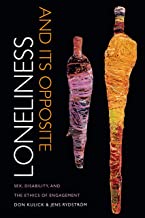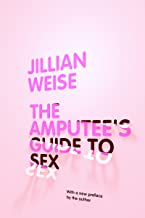Disability Sexuality Resources
Disabled does not mean asexual. Everyone, including you, deserves a great love life.
The Ultimate Guide to Sex and Disability: For All of Us Who Live with Disabilities, Chronic Pain, and Illness
by Miriam Kaufman , Cory Silverberg, and Fran Odette

The Ultimate Guide to Sex and Disability is the first complete sex guide for people who live with disabilities, pain, illness, or chronic conditions. Useful for absolutely everyone, regardless of age, gender, or sexual orientation, the book addresses a wide range of disabilities — from chronic fatigue, back pain, and asthma to spinal cord injury, hearing and visual impairment, multiple sclerosis, and more. Expertly written by a medical doctor, a sex educator, and a disability activist, The Ultimate Guide provides readers with encouragement, support, and all the information they need to create a sex life that works for them. The authors cover all aspects of sex and disability, including building a positive sexual self-image; positions to minimize stress and maximize pleasure; dealing with fatigue or pain during sex; finding partners and talking with partners about sex and disability; adapting sex toys; and more.
Love, Sex, and Disability: The Pleasures of Care (Disability in Society)
by Sarah Smith Rainey (Author)

In this exploration of intimate relationships between people with physical disabilities and those without, Sarah Smith Rainey shatters the myth of sexless, burdensome partnerships and in its place reveals a rich and rewarding continuum of emotional and physical intimacies. Rainey draws on interviews, autobiographies, and films to show how disabled/nondisabled couples not only build mutually satisfying relationships by giving and receiving in equal measure, but also move beyond traditional gender roles to create new forms of sexual intimacy. She also takes note of the challenges these couples face. With sensitivity and clarity, she offers an unparalleled portrait of the lived experience of disability and sexuality.
Sex and Disability
by Robert Mcruer and Anna Mollow

The title of this collection of essays, Sex and Disability, unites two terms that the popular imagination often regards as incongruous. The major texts in sexuality studies, including queer theory, rarely mention disability, and foundational texts in disability studies do not discuss sex in much detail. What if "sex" and "disability" were understood as intimately related concepts? And what if disabled people were seen as both subjects and objects of a range of erotic desires and practices? These are among the questions that this collection's contributors engage. From multiple perspectives—including literary analysis, ethnography, and autobiography—they consider how sex and disability come together and how disabled people negotiate sex and sexual identities in ableist and heteronormative culture. Queering disability studies, while also expanding the purview of queer and sexuality studies, these essays shake up notions about who and what is sexy and sexualizable, what counts as sex, and what desire is. At the same time, they challenge conceptions of disability in the dominant culture, queer studies, and disability studies.
Loneliness and Its Opposite: Sex, Disability, and the Ethics of Engagement
by Don Kulick and Jens Rydström

Few people these days would oppose making the public realm of space, social services and jobs accessible to women and men with disabilities. But what about access to the private realm of desire and sexuality? How can one also facilitate access to that, in ways that respect the integrity of disabled adults, and also of those people who work with and care for them?
Loneliness and Its Opposite documents how two countries generally imagined to be progressive engage with these questions in very different ways. Denmark and Sweden are both liberal welfare states, but they diverge dramatically when it comes to sexuality and disability. In Denmark, the erotic lives of people with disabilities are acknowledged and facilitated. In Sweden, they are denied and blocked. Why do these differences exist, and how do both facilitation and hindrance play out in practice?
Loneliness and Its Opposite charts complex boundaries between private and public, love and sex, work and intimacy, and affection and abuse. It shows how providing disabled adults with access to sexual lives is not just crucial for a life with dignity. It is an issue of fundamental social justice with far reaching consequences for everyone..
The Amputee's Guide to Sex
by Jillian Weise (Author)

A Los Angeles Review Best Book of the Year
“Readers who can handle the hair-raising experience of Jillian Weise’s gutsy poetry debut . . . will be rewarded with an elegant examination of intimacy and disability and a fearless dissection of the taboo and the hidden.” - Los Angeles Times
When Jillian Weise wrote The Amputee’s Guide to Sex, it was with the intention of changing the conversation around disability; essentially, she was tired of seeing “cripples” portrayed as asexual characters. The collection that resulted is a powerful lesson in desire, the body, pain, and possession. These poems interrogate medical language and history, imagine Mona Lisa in a wheelchair, rewrite Elizabeth Bishop’s poem “In the Waiting Room,” address a lover’s arsonist ex-girlfriend, and show the prosthesis as the object of male curiosity and lust. Publishers Weekly, in a starred review, called the book a “charged and daring debut” and described Jillian Weise as an “agile and powerful poet . . . speaking boldly and compassionately about a little-discussed subject that becomes universal in her careful hands.”
Ten years since its first publication, our culture continues to grapple with questions limned in this collection. In a new introduction, Weise revisits and recontextualizes her work, revealing its urgency to our present moment. What are the challenges of speaking “for” a community? How to resist the institutionalization of ableist paradigms? How are atypical bodies silenced? Where do our corporeal selves intersect with our technologies?
What's Happening to Tom?: A book about puberty for boys and young men with autism and related conditions (Sexuality and Safety with Tom and Ellie)
by Kate E. Reynolds (Author), Jonathon Powell (Illustrator)

Tom notices that his body is changing. Tom's voice is different and hair is growing in new places. There are other changes happening too. Tom learns that he has started growing into a man.
Following Tom as he begins to notice changes to his body, this simple resource helps parents and carers teach boys with autism or other special needs about puberty. It covers all the changes that they will experience, both emotional such as new feelings and physical such as wet dreams. This fully illustrated positive and entertaining book provides the perfect opportunity to talk about puberty with boys and young men with autism or special needs.
